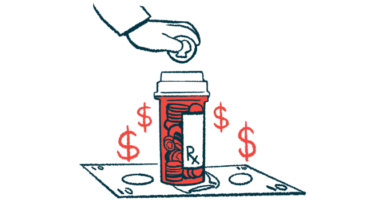SOD1-ALS disease progression may slow with RAG-17: Final trial data
Nerve damage biomarkers, SOD1 protein declined with therapy

An experimental candidate by Ractigen Therapeutics to treat amyotrophic lateral sclerosis (ALS) linked to mutations in the SOD1 gene has shown promising signs of slowed functional decline and stable or improved breathing in ALS patients of a small early trial.
The therapy, RAG-17, also significantly reduced blood levels of neurofilament light chain (NfL), a biomarker of nerve damage, and demonstrated target engagement, as indicated by a drop in SOD1 protein levels.
That’s according to final results of an investigator-initiated, early Phase 1 clinical trial (NCT05903690) shared by Weiqi Chen, MD, from the Beijing Tiantan Hospital in China in an oral presentation at the American Academy of Neurology (AAN) 2025 Annual Meeting this month in San Diego and online. The presentation was titled “RAG-17 a Novel siRNA Therapy for SOD1-ALS: Safety and Preliminary Efficacy from a First-in-human Trial.”
The AAN Science Committee selected the abstract that summarized the presentation for the Abstracts of Distinction award, an honor based on study quality and interest to the neurologic community.
“We are thrilled that our RAG-17 program has been honored with an Abstract of Distinction at the AAN 2025 meeting,” Long-Cheng Li, MD, Ractigen’s president and CEO, said in a company press release. “This recognition highlights the significance of our work in addressing the unmet needs of SOD1-ALS patients.”
An ongoing Ractigen-sponsored Phase 1 trial (NCT06556394) testing RAG-17 against a placebo in about 32 people with SOD1-ALS dosed its first participant last year. That study will evaluate the safety, tolerability, pharmacological properties, and preliminary efficacy of multiple RAG-17 dose levels.
“The positive final data from our [investigator-initiated trial], demonstrating favorable safety, robust target knockdown, and encouraging biomarker and clinical signals, combined with the ongoing progress in our Phase I trial, reinforce our commitment to bringing this innovative therapy to those who need it most,” Li said.
What is RAG-17?
Mutations in the SOD1 gene, which codes for an antioxidant enzyme of the same name, are associated with ALS in up to 20% of familial cases, in which multiple family members are affected, and about 2% of sporadic cases.
These mutations result in an abnormal SOD1 enzyme that’s unable to neutralize potentially damaging molecules, called free radicals, generated during normal metabolic processes. The defective enzyme also forms toxic clumps that further contribute to ALS-related neurodegeneration.
RAG-17 is a small interfering RNA, or siRNA, molecule designed to lower the abnormal SOD1 enzyme’s levels. It binds to SOD1‘s messenger RNA, the intermediate molecule generated from DNA that serves as a template for protein production, targeting it for destruction and suppressing SOD1 enzyme production.
Led by Beijing Tiantan Hospital vice president Yilong Wang, MD, PhD, the completed study enrolled six adults with SOD1-ALS, all of whom received RAG-17 by an intrathecal injection, that is, into the spinal canal. The participants began with a 60 mg dose. This was increased every two weeks to reach an optimal dose, which was then given every other month for up to eight months.
Preliminary findings reported last year suggested RAG-17 was well tolerated at all doses and led to meaningful changes in disease biomarkers and clinical outcomes. No detailed data were provided at the time, however.
The trial’s final data, presented at AAN, confirmed RAG-17’s safety profile. No dose-limiting toxicities or serious adverse events were reported, and most adverse events, including headaches and muscle tremors in two patients each, were mild and temporary.
‘Encouraging’ results of treatment
RAG-17 was also associated with an average 2.17-point drop in the ALS Functional Rating Scale-Revised (ALSFRS-R) score, with higher scores indicating better function. This was equivalent to a 0.29-point monthly decline, which may reflect a slower functional decline when compared with a typical 1 point drop per month in ALS clinical trials.
At the same time, a standard measure of lung function called forced vital capacity remained stable in most patients, with two showing significant improvement from the study’s start.
Significant target engagement was also demonstrated, with RAG-17 leading to a pronounced drop in SOD1 levels in the cerebrospinal fluid (CSF) that surrounds the brain and spinal cord, exceeding 50% in all but one patient. The experimental therapy also significantly reduced blood NfL levels, “suggesting a potential impact on neurodegeneration,” the release stated.
“The safety profile and early efficacy signals, particularly the significant reduction in CSF SOD1 and [blood] NfL levels alongside stable functional measures, are encouraging,” Wang said. “The results presented at AAN 2025 demonstrate the potential of RAG-17 to significantly impact the lives of patients with SOD1-ALS.”
The Phase 1 trial for RAG-17 is advancing as planned, according to Ractigen. Enrollment is complete for the first two groups of patients, each receiving a different dose level.
“We look forward to continuing our work in the Phase 1 study to further validate these findings and bring this therapy closer to clinical application,” Wang said.







